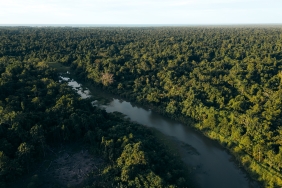SUMATRAN TIGER SCIENTIFIC STUDY "TIGERS NEED COVER" LAUNCHED
JAKARTA--One of the leading scientific journals PLOS One yesterday (23/1) published a scientific study on Sumatran tigers written by a number of tiger researchers from WWF Indonesia, Virginia Tech and supported by the Indonesian Ministry of Forestry. The study titled "Tigers Need Cover" is the result of research conducted across a range of land cover types in central Sumatra. It is also the first study to systematically investigate and compare tiger habitat use across different land covers, not only in forests but also in plantation areas.
The following is an excerpt of WWF-Indonesia's Desma Murni's written interview with one of the lead authors of the study, Sunarto PhD who is also the Coordinator of the Sumatran Tiger and Elephant Conservation Program at WWF-Indonesia.
If you can tell us in a nutshell, what are the most important findings in the "Tiger Needs Cover" paper?
This study found that under certain conditions tigers can use acacia plantations, oil palm plantations, and rubber plantations as their home range. However, considering the availability of prey, tigers tend to avoid plantations and prefer forests. Conditions preferred by tigers, in addition to sufficient prey availability, are a short distance from the center point of large forest blocks (>50,000 ha), dense understory cover, and minimal levels of human activity.
Does this suggest that to remain sustainable, tigers need large tracts of forest?
Yes, tigers need large tracts of intact forest to remain sustainable. In fragmented conditions, tiger habitat and populations may be restored by establishing linkages between separate forest blocks. With special management, some areas of forest plantations and plantations can be optimized as additional habitat, pathways, and 'stepping stones' for tigers so that they can move from one forest block to another. For example, to visit their relatives and enrich each other's genetic diversity.
What is the main message that WWF wants to convey to the public through this "Tiger needs cover" article?
The message to the public is that tiger conservation, especially under conditions where tiger habitat forests have been heavily converted and fragmented, requires creative new approaches based on accurate data and analysis. This study is just the beginning of our efforts to understand the characteristics of habitat that tigers need/prefer. From the results of this study, we can identify what efforts are needed to restore tiger habitat and populations. This is in line with the commitment to restore tiger habitat and populations agreed upon globally by 13 tiger range countries, including Indonesia last year.
This is the first study to systematically investigate and compare habitat use by tigers across different land covers, not only in forests but also in plantation areas. The study also looks at habitat use across multiple spatial scales, an important but rare approach in animal ecology research, especially tigers. The determination of the Indonesian government and the global community to restore tiger populations must start with a deep understanding of tiger ecology and be followed by strategic steps and concrete actions both on the ground and in policy-making spaces.
###
The full study "Tigers Need Cover: A Multi-Scale Occupancy Study of the Big Cat in Sumatran Forest and Plantation Landscapes" can be read online and downloaded at http://assets.wwf.or.id.wwf-web-1.bluegecko.net/downloads/tigers_need_cover.pdf. For more information about this study, please contact Sunarto PhD at s.sunarto@yahoo.com.




